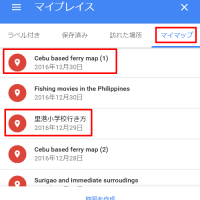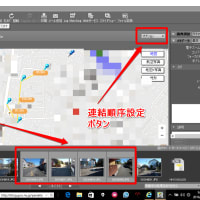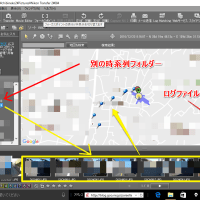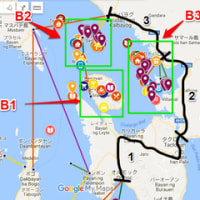I made it! I made it! No shears! All 17 of them!

Naturally, there will have to be a few improvements,
but the sheer fact remains that you can, overnight,
fix up on the bootsholder pieces in one go.

A above is showing you a possible mechanism of arc formation
The blue end on the left is a stopper, and yet, alhough very firmly
fixed to the base it does go away from its vertical position as
lateral pressure is applied.
Each of the bootsholder pieces will go along with that, making them
slide up on its immediate neighbouring piece, thus forming an arc.
The horizontal green arrow is the lateral pressure.
The ultimate solution would be to have a very solid block at
the end of the base. With that in mind I went to a DIY shop, and
found a pipe crumper.
It uses a 3/4 inch water pipe as its mainstructural member
and the end block is very solidly made, cast iron and all that.
There are certainly small gaps, inevitable with any threads
using device, which might contribute towards its back end
falling back a bit, but my guess is that it will not be
as significant as in the case of wooden stopper. Unfortunately,
much I wanted to buy one, no suitable diameter pipes were
available. I will have to look around!

Most of today was really spent on preparatory operations. Virtually
all of my work involves, and requires rectangular blocks
of wood, with varying degrees of length, thickness etc, etc.
Seen above are some leftovers from my earlier work on large
spoons. They originate in the parts that were adjacent to the
spoon stems.
With a small business like mine you cannot waste them!

Above and what to follow next are really showing you how to
go about deciding on the material width, thickness you
require.
It is one thing to have templates for your top and side profiles.
However, deciding on the required material width, thickness
is another matter.
Schematics above, B and C may be of help. Yes, I use
these L shaped alminium igs a lot. I just place my
template on these and the angle with the nearest
dimension will be picked up. For instance, the image above
is matching the side profile of a particular spoon
against one of the jigs.
Small discrepancies are ignored, simply because any of these
unwanted portions will be sanded outin the fabrication
process.

On the other hand something like above cannot be
tolerated. Jig is much too wide. In cases like this I will
place the template directly on the wood and draw
a reference line, along which the wood is to be cut. This
rarely happens, and most of the time I simply place
my jig on the wood and draw my cutting lines.
Images that follow showing you what stage I got to by the
end of my working hours, 10:00 to 16:00.


You remember me talking about the mail-ordered Borneo
iron wood? Me spending JPY 1000 on the wood itself and ending up
paying JPY 2000 for the delivery?
Rejyoce!!! I found a DIY shop, not too far from here,
where they have stocks!I am actually going mad about this
whole business!




Naturally, there will have to be a few improvements,
but the sheer fact remains that you can, overnight,
fix up on the bootsholder pieces in one go.

A above is showing you a possible mechanism of arc formation
The blue end on the left is a stopper, and yet, alhough very firmly
fixed to the base it does go away from its vertical position as
lateral pressure is applied.
Each of the bootsholder pieces will go along with that, making them
slide up on its immediate neighbouring piece, thus forming an arc.
The horizontal green arrow is the lateral pressure.
The ultimate solution would be to have a very solid block at
the end of the base. With that in mind I went to a DIY shop, and
found a pipe crumper.
It uses a 3/4 inch water pipe as its mainstructural member
and the end block is very solidly made, cast iron and all that.
There are certainly small gaps, inevitable with any threads
using device, which might contribute towards its back end
falling back a bit, but my guess is that it will not be
as significant as in the case of wooden stopper. Unfortunately,
much I wanted to buy one, no suitable diameter pipes were
available. I will have to look around!

Most of today was really spent on preparatory operations. Virtually
all of my work involves, and requires rectangular blocks
of wood, with varying degrees of length, thickness etc, etc.
Seen above are some leftovers from my earlier work on large
spoons. They originate in the parts that were adjacent to the
spoon stems.
With a small business like mine you cannot waste them!

Above and what to follow next are really showing you how to
go about deciding on the material width, thickness you
require.
It is one thing to have templates for your top and side profiles.
However, deciding on the required material width, thickness
is another matter.
Schematics above, B and C may be of help. Yes, I use
these L shaped alminium igs a lot. I just place my
template on these and the angle with the nearest
dimension will be picked up. For instance, the image above
is matching the side profile of a particular spoon
against one of the jigs.
Small discrepancies are ignored, simply because any of these
unwanted portions will be sanded outin the fabrication
process.

On the other hand something like above cannot be
tolerated. Jig is much too wide. In cases like this I will
place the template directly on the wood and draw
a reference line, along which the wood is to be cut. This
rarely happens, and most of the time I simply place
my jig on the wood and draw my cutting lines.
Images that follow showing you what stage I got to by the
end of my working hours, 10:00 to 16:00.


You remember me talking about the mail-ordered Borneo
iron wood? Me spending JPY 1000 on the wood itself and ending up
paying JPY 2000 for the delivery?
Rejyoce!!! I found a DIY shop, not too far from here,
where they have stocks!I am actually going mad about this
whole business!























※コメント投稿者のブログIDはブログ作成者のみに通知されます